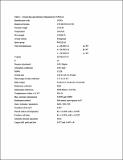Por favor, use este identificador para citar o enlazar a este item:
http://hdl.handle.net/10261/113902COMPARTIR / EXPORTAR:
 SHARE SHARE
 CORE
BASE CORE
BASE
|
|
| Visualizar otros formatos: MARC | Dublin Core | RDF | ORE | MODS | METS | DIDL | DATACITE | |

| Título: | Solution and structure of an alternating D,L-peptide |
Autor: | Alexopoulos, Eftichia; Küsel, Andrea; Sheldrick, George M.; Diederichsen, Ulf; Usón, Isabel CSIC ORCID | Palabras clave: | fragment search MR SIRAS SHELXE SHELXD anomalous scattering D,L-alterning peptides iodide soaking |
Fecha de publicación: | 26-oct-2004 | Editor: | Blackwell Publishing | Citación: | Acta Crystallographica Section D: Biological Crystallography 60(11): 1971-1980 (2004) | Resumen: | The crystal structure of H-(L-Tyr-D-Tyr)4-L-Lys-OH has been determined to 1.3 Å resolution. The D,L-alternating peptide crystallizes in the tetragonal system, space group P43212, with unit-cell parameters a = b = 27.99 (3), c = 78.93 (8) Å. The crystals contain two molecules in the asymmetric unit that form a double-stranded right-handed antiparallel β-helix. The structure has been solved by SIRAS using a crystal soaked in an iodide-containing solution for 1 min. The programs SHELXD and SHELXE were used to determine the iodide substructure and also the experimental electron-density map. Using the coordinates of known D,L-peptides deposited in the PDB, several attempts were made to solve the structure by molecular-replacement techniques. Although the backbone of the MR model selected shows great similarity and was used to trace the actual peptide structure in the map, it was not possible to obtain the correct solution before the experimental phases became available. The correct fragment orientations are easily determined, but the same does not apply to the translation search. Nevertheless, insights into fragment search and expansion were gained from the tests described in this paper. The correlation coefficient calculated with the resolution shell of data around 2.4 Å, a distance corresponding to most 1-3 interatomic vectors, is a particularly good discriminator of correct orientations in the rotation search of small fragments. © 2004 International Union of Crystallography. | Versión del editor: | http://dx.doi.org/10.1107/S0907444904022292 | URI: | http://hdl.handle.net/10261/113902 | DOI: | 10.1107/S0907444904022292 | Identificadores: | doi: 10.1107/S0907444904022292 issn: 0907-4449 |
| Aparece en las colecciones: | (IBMB) Artículos |
Ficheros en este ítem:
| Fichero | Descripción | Tamaño | Formato | |
|---|---|---|---|---|
| Alexopoulos-Acta-Crystallographica-D-2004-v60-n11-p1971.pdf | 2,88 MB | Adobe PDF |  Visualizar/Abrir | |
| Alexopoulos-Acta-Crystallographica-D-2004-v60-n11-supplementary.pdf | 75,2 kB | Adobe PDF |  Visualizar/Abrir |
CORE Recommender
SCOPUSTM
Citations
11
checked on 13-abr-2024
WEB OF SCIENCETM
Citations
12
checked on 12-feb-2024
Page view(s)
315
checked on 18-abr-2024
Download(s)
402
checked on 18-abr-2024
Google ScholarTM
Check
Altmetric
Altmetric
NOTA: Los ítems de Digital.CSIC están protegidos por copyright, con todos los derechos reservados, a menos que se indique lo contrario.
